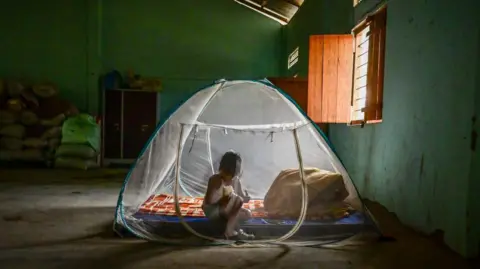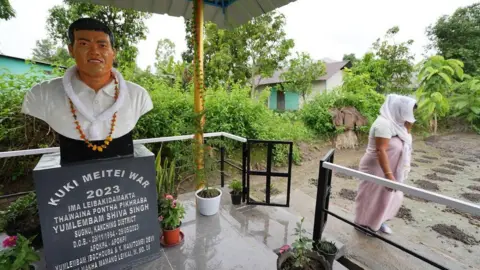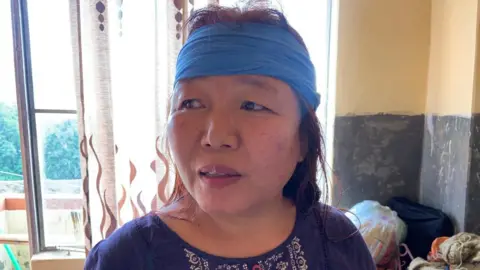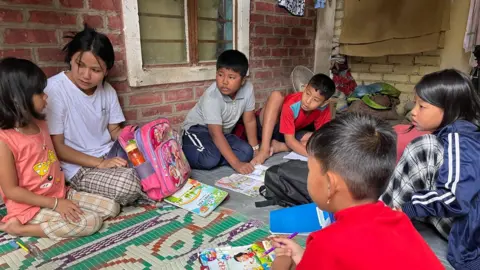[ad_1]
 Getty Images
Getty ImagesMore than a yr has handed since a lethal ethnic battle devastated properties and claimed over 220 lives in India’s north-eastern Manipur state. But its greater than three million residents are nonetheless ready for peace.
Clashes erupted in May final yr between the bulk Meitei and indigenous minority Kuki teams – they had been sparked by Kuki protests towards calls for from Meiteis to be given official tribal standing, which might make them eligible for affirmative motion and different advantages.
The violence displaced tens of 1000’s – some 59,000 individuals are nonetheless residing in authorities aid camps. It has break up up neighbourhoods and torn aside bonds between communities.
Today, Manipur is split into two camps, with Meiteis inhabiting the Imphal Valley and Kukis residing within the surrounding hill areas. Borders and buffer zones guarded by safety forces separate the 2 areas. Many locals have voluntarily taken up arms – some stolen from armed forces, some country-made – to guard their villages from intruders.
Federal and state officers have made some makes an attempt to finish the battle by holding peace talks between the communities, however locals say it hasn’t been sufficient – a current peace deal signed in a district collapsed inside a day. Distrust between the 2 teams persists and incidents of violence, together with killings of safety personnel, are recurrently reported.
“The situation in Manipur is still tense and full of mistrust because people have to be confident about moving forward – and to move forward, there has to be some resolution of the past. There hasn’t been one,” says Sanjoy Hazarika, a commentator and writer who specialises in India’s north-eastern states.
Both communities blame the opposite for stoking violence.
The state authorities and the Meitei group have often blamed unlawful immigration – particularly from neighbouring Myanmar – for the battle. The Kuki group, which shares ethnic ties with the Chins in Myanmar, say this narrative has been used to focus on them inside their very own state.
“The state needs a full-fledged intervention: militarily to stop the violence and psychologically to start negotiations. The establishment of trust [between Kukis and Meiteis] is crucial. Trust cannot be built in a day,” says Shreema Ningombam, a political analyst in Imphal, the state capital.
 Anshul Verma
Anshul VermaIn Sugnu village, about 60km (37 miles) from Imphal, the divide is stark.
It was as soon as residence to each Meiteis and Kukis, however the latter fled to the encircling hills after the battle started, forsaking burnt and ransacked homes.
Despite heavy safety, locals worry retaliatory assaults from “outsiders”. Meitei girls teams, referred to as Meira Paibis, guard village entry factors.
Yumlembam Manitombi, one of many guards, stated she misplaced her 29-year-old son in final yr’s violence. He was the eldest of her three youngsters and the only real supplier for the household.
They have put in a bust of him within the courtyard of their home. An engraving beneath the bust marks the explanation for his dying – it says Kuki Meitei War 2023.
“I want peace. Ending this war is my sole wish and I seek nothing more,” Ms Manitombi says.
United in disappointment
In Churachandpur, the Kuki-dominated epicentre of the battle, related safety measures exist. The entrance to the town contains a “Wall of Remembrance” commemorating Kukis who died within the battle.
Boinu Haokip and her household fled from Sugnu to Churachandpur final yr to flee violence and now survive on odd jobs.
Ms Haokip, who’s doing analysis on ethnic violence in Manipur, says her future appears bleak.
“I have to study and look after my family. Our society was in poverty for generations. We had begun coming out of it, but this violence has pushed us back at least a decade,” she says.
Questions about the future haunt others too as schools become makeshift camps. People have lost businesses, land and jobs and exhausted their savings.
The conflict has also forced some to flee to camps in the neighbouring state of Mizoram. With shortages of food, water, and medicine, people rely on odd jobs to survive.
Nengnei Chong, 52, fled with her two sons and has been living in a relief camp outside Mizoram’s capital Aizawl. But she says she regrets her decision to leave.
“It would have been better had we too died back home,” she says.
Mizoram lawmaker TBC Lalvenchhunga says the state government has limited resources.
“The government is financially struggling. If the federal government heeds our repeated requests [for more funds], we can help the refugees better,” he says.
 Dilip Kumar Sharma
Dilip Kumar SharmaPolitical blame game
Locals accuse the Bharatiya Janata Party-run Manipur and federal governments of not doing enough to quell the violence.
Kuki groups have accused state authorities of ignoring violence by Meiteis for political benefit, which the government denies. Opposition parties say federal government let the conflict rage on for too long. The Congress party has repeatedly criticised Prime Minister Narendra Modi for not visiting Manipur.
“Our government is making serious efforts to bring back normalcy in Manipur. Schools, colleges and offices in most places have opened up and are functioning. The hope for peace is visible,” Mr Modi said in parliament recently.
But experts say mistrust between the two communities has only hardened and the divide has deepened with the Kukis steadfastly demanding a “separate administration”, one thing the Meiteis vehemently oppose.
 Mayuresh Konnur
Mayuresh Konnur“Peace-building is a very painful and slow process. It is easier to indulge in violence than to build peace. If the centre [federal government] is able to bring both sides to the table, it will be a step in the right direction,” Mr Hazarika says.
But he cautions that this may not be a fast course of.
“Healing needs time and patience before you can really move forward.”
With inputs from Dilip Kumar Sharma in Mizoram
[ad_2]
Source link


